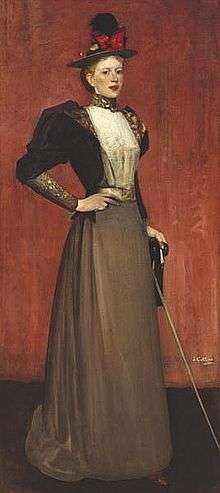Maggie Hamilton
Margaret Hamilton (1867–21 January 1952) was a Scottish artist known for her paintings and embroidery work.
Maggie Hamilton | |
|---|---|
 Maggie Hamilton by James Guthrie | |
| Born | Margaret Hamilton 1867 Glasgow, Scotland |
| Died | 21 January 1952 Helensburgh, Scotland |
| Nationality | Scottish |
| Known for | Embroidery, painting |
| Spouse(s) | Alexander Nisbet Paterson |
Biography
Hamilton was born in Glasgow and grew up in Helensburgh after her family moved there.[1] Although she had no formal artistic training, Hamilton became associated with the Glasgow Boys through her elder brother, James Whitelaw Hamilton.[2] In 1883, while staying with her brother at Cockburnspath, where the Glasgow Boys were spending their summers, Hamilton was asked to help James Guthrie's mother with domestic work.[1][2] Guthrie subsequently painted several portraits of Hamilton, most notably his 1892 diploma group portrait, Midsummer.[1]
In 1897 Hamilton married the architect Alexander Nisbet Paterson, the younger brother of the artist James Paterson.[3] The family home, The Long Croft was designed by Paterson and decorated by Hamilton in the Arts and Crafts style with figure and floral designs and embroideries.[4] For some time Hamilton had been creating oil paintings of flowers but also began painting still-life compositions.[4] In the late 1890s her Chinese silk embroideries were widely praised.[1]
Throughout her career, Hamilton had over ninety works shown at the Royal Glasgow Institute of the Fine Arts and over forty at the Royal Scottish Academy.[1] She was a member of the Glasgow Society of Lady Artists and twice served three-year terms as its Vice President.[2]
Hamilton and Paterson had two children together, including the artist Viola Paterson.[3] In 1977 the Belgrave Gallery in London held a group exhibition of works by members of the Paterson family that included a large embroidery by Hamilton, one that she had worked on for five years.[3] Kelvingrove Art Gallery and Museum holds examples of her work.[1]
References
- Peter J.M. McEwan (1994). The Dictionary of Scottish Art and Architecture. Antique Collectors' Club. ISBN 1 85149 134 1.
- Paul Harris & Julian Halsby (1990). The Dictionary of Scottish Painters 1600 to the Present. Canongate. ISBN 1 84195 150 1.
- David Buckman (2006). Artists in Britain Since 1945 Vol 1, A to L. Art Dictionaries Ltd. ISBN 0 953260 95 X.
- Jude Burkhauser (Editor) (1990). Glasgow Girls Women in Art and Design 1880-1920. Canongate. ISBN 184195151X.CS1 maint: extra text: authors list (link)
External links
- 1 painting by or after Maggie Hamilton at the Art UK site